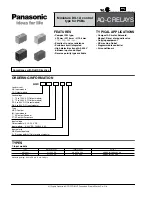
5-6
BE1-51/27R - Tests And Adjustments
NOTE
Ensure that the voltage sense terminals and current sense terminals are connected to
the same phase.
Step 6.
Slowly increase the current toward the value of the front panel TAP selector A setting until the front
panel TIMING indicator illuminates. Do not disturb this setting.
Step 7.
Record the current reading and remove input current.
RESULT: The recorded value should be within ±5% of the front panel TAP selector A setting for
the phase minimum overcurrent pickup point for the time overcurrent.
Step 8.
Set the front panel TAP selector to J.
Step 9.
Slowly adjust the test set, increasing the overcurrent threshold toward the value of the front panel
TAP selector J setting until the front panel TIMING indicator just illuminates. Do not disturb this
setting.
Step 10. Record the current reading and remove input current.
RESULT: The recorded value should be within ±5% of the front panel TAP selector J setting for
the phase maximum overcurrent pickup point for the time overcurrent element.
Step 11. Perform the following steps as appropriate for the correct sensing input types.
(a) Sensing Input Type M or N (Single-Phase Sensing). This concludes the time overcurrent
test. Proceed to the timed output test.
(b) Sensing Input Type Y or Z (Two-Phase and Neutral Sensing). Remove the power and
reconnect the input sensing to the remaining phases as shown in Figure 5-6, each time
repeating Steps 1 through 10. For neutral testing continue with Step 12.
(c) Sensing Input Type B, C, R, or S (Three-Phase Sensing). Remove the power and re-
connect the input sensing to each of the remaining phases as shown in Figures 5-4 and 5-6,
each time repeating Steps 1 through 10.
(d) Sensing Input Types E, F, U, or W (Three-Phase with Neutral Sensing). Remove the power
and reconnect the input sensing to each of the remaining phases as shown in Figures 5-3
and 5-5, each time repeating Steps 1 through 10. For neutral testing continue with Step 12.
Step 12.
Perform the preliminary instructions.
For the neutral sensing (terminals 17 and 18), connect the relay as shown in Figures 5-3 and
5-5, then perform the following steps (Steps 13 through 21).
Step 13.
Set the front panel TAP (NEUTRAL) selector to A.
Step 14.
Adjust the test set for an overcurrent threshold having one of the following values:
a) 0.5 A for relays with Sensing Input Range 2 or 3.
b) 1.5 A for relays with Sensing Input Range 4 or 5.
Step 15. Slowly adjust the front panel CAL (NEUTRAL) control CCW until the front panel TIMING indicator
illuminates.
RESULT: For the neutral minimum overcurrent pickup point of 0.5 A (Step 16a., above) or 1.5 A
(Step 16b., above) the front panel CAL (NEUTRAL) control should be near its maximum CCW
limit.













































